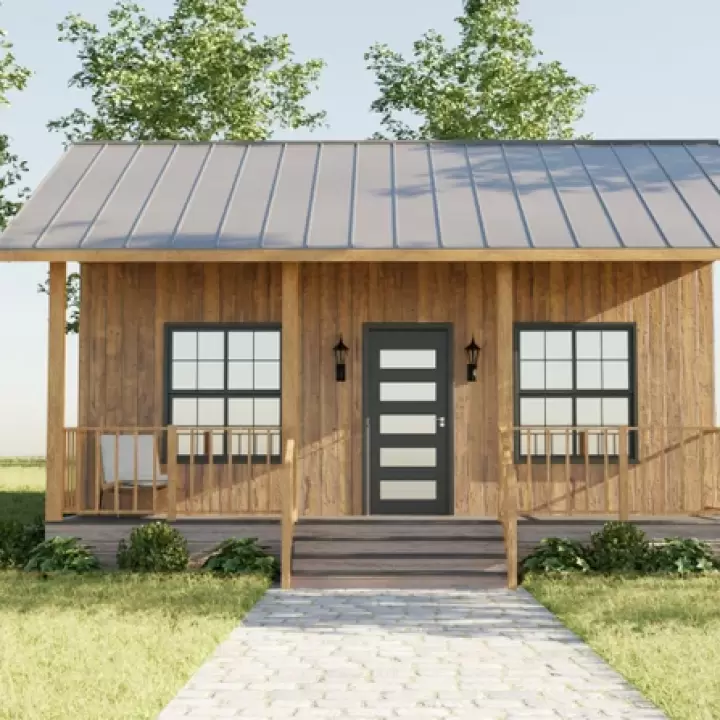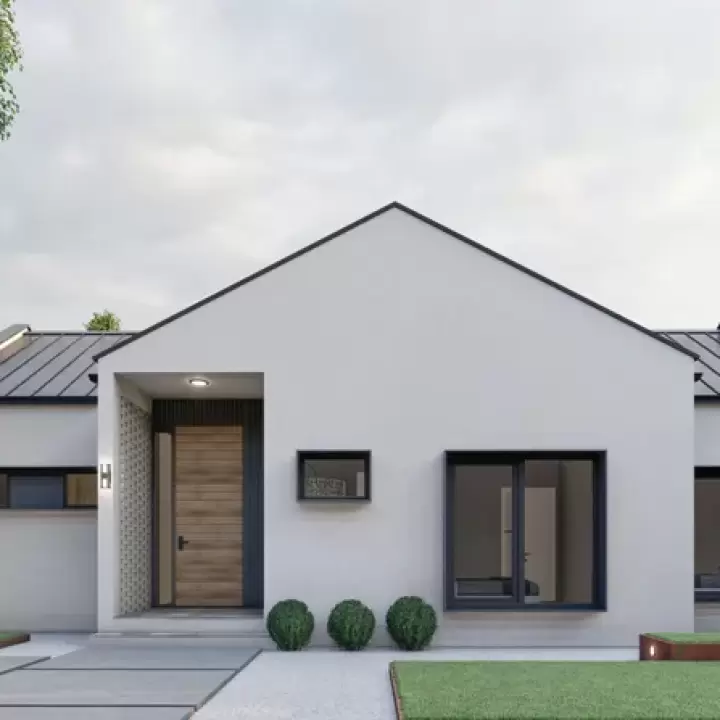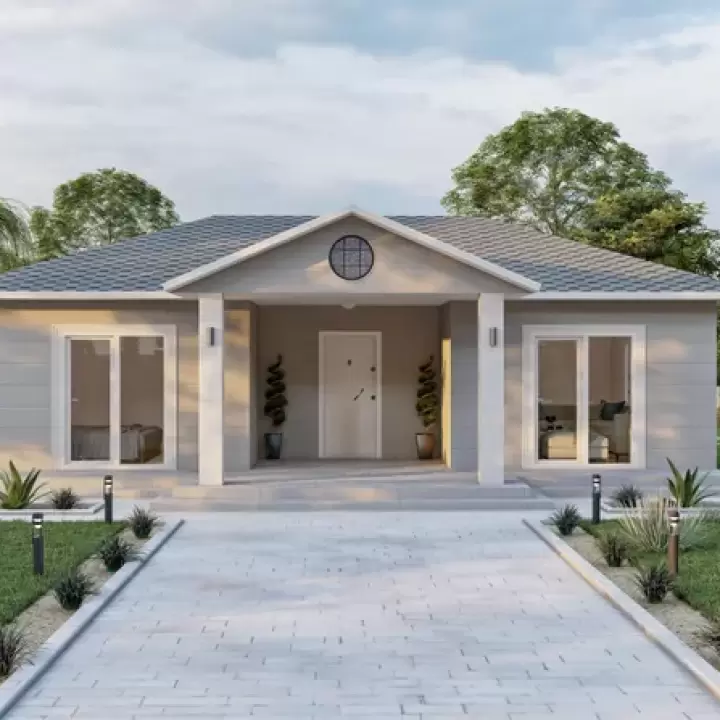
DIY A-Frame Cabin Design: Hands-On Plans and Detailed Blueprints
If you're dreaming of building your own serene retreat in the woods or a cozy cabin by the lake, an A-frame cabin might be the perfect choice. Known for its simple, yet elegant design, the A-frame cabin offers a blend of rustic charm and modern living that is both aesthetically pleasing and structurally efficient. In this guide, we'll explore the detailed DIY plans and blueprints for a 44' x 29' A-frame cabin, providing you with all the information you need to embark on this rewarding project.
What is an A-Frame Cabin?
An A-frame cabin is a type of architectural design characterized by its steeply angled roof that forms the shape of the letter "A". This unique design not only gives the cabin its distinctive look but also serves practical purposes such as shedding snow and rain easily, making it ideal for various climates.
A-frame cabins are typically straightforward to construct, making them a popular choice for DIY enthusiasts. The design's simplicity, combined with its ability to maximize space, makes it a versatile option for those looking to build anything from a small weekend getaway to a spacious family home.
About the 44' x 29' A-Frame Cabin DIY Plans
The 44' x 29' A-Frame Cabin DIY Plans offer a comprehensive guide to building a spacious and inviting cabin that seamlessly blends rustic charm with modern comforts. These blueprints are meticulously detailed to ensure that even first-time builders can follow along with confidence.
Ground Floor Plan (1,442 sq.ft)
The ground floor of this A-frame cabin is designed with both functionality and comfort in mind. Here's a breakdown of the spaces included:
- Kitchen (15'-1'' x 8'-10'', 133.50 sq.ft): The kitchen is designed to be both functional and stylish, offering ample space for culinary creativity. Whether you're preparing a quick meal or hosting a dinner party, this kitchen is equipped to handle it all.
- Living Room (24'-11'' x 20'-4'', 507 sq.ft): The expansive living room is the heart of the cabin, providing plenty of space for relaxation and entertaining. With its open layout, this room can easily accommodate large gatherings or cozy family nights.
- Bedroom 1 (11'-10'' x 14'-1'', 166.85 sq.ft): The first bedroom is a peaceful retreat, designed to provide plenty of natural light and a comfortable sleeping area. It's the perfect spot to unwind after a day of outdoor activities.
- Bedroom 2 (11'-10'' x 14'-9'', 174.40 sq.ft): This additional bedroom is perfect for family or guests. Like the first bedroom, it offers plenty of space and natural light, ensuring a comfortable stay for everyone.
- Dining Room (9'-10'' x 11'-6'', 116.25 sq.ft): The dining room is ideally situated for family meals and gatherings, making it a central part of the home. Its proximity to the kitchen and living room ensures easy access and a seamless flow between spaces.
- Bath (6'-11'' x 8'-10'', 61.35 sq.ft): The well-appointed bathroom on the ground floor is designed for convenience, offering all the essentials in a compact space.
- Antre (6'-11'' x 22'-8'', 200 sq.ft): The antre serves as a spacious entryway that welcomes you home. It provides a buffer between the outdoor elements and the interior of the cabin, adding to the overall comfort and functionality of the space.
- Porch (8'-6'' x 29'-10'', 255 sq.ft): The inviting porch is perfect for enjoying the outdoors, whether you're sipping your morning coffee or watching the sunset. Its generous size allows for a variety of outdoor furniture and activities.
- Entrance (8'-6'' x 4'-3'', 36.60 sq.ft): The entrance area is practical and charming, ensuring easy access to the cabin while adding to its overall appeal.
First Floor Plan (322.40 sq.ft)
The first floor of the cabin is dedicated to the master suite, offering a luxurious and private retreat.
- Master Bedroom (12'-2'' x 17'-5'', 211 sq.ft): The master bedroom is a spacious and comfortable space, designed to offer privacy and tranquility. With its ample size, it can accommodate a king-size bed and additional furniture, making it a true retreat within the cabin.
- Bath (4'-11'' x 11'-6'', 56.50 sq.ft): The second bathroom on the first floor adds convenience and functionality, ensuring that the master suite is fully self-contained.
- Hall (3'-11'' x 5'-7'', 21.50 sq.ft): The hall connects the master bedroom and bathroom, seamlessly integrating the spaces and enhancing the overall flow of the floor plan.
House Features
The 44' x 29' A-frame cabin is designed with practicality and aesthetics in mind. Here are some key features of the cabin:
- Build Dimensions: 44'-11'' x 11'-6''
- Rooms: 1 kitchen, 1 living room, 3 bedrooms, 1 antre, 2 baths, 1 porch, 1 entrance, 1 dining room, and 1 hall.
- Ground Floor Height: 9'-10''
- First Floor Height: 8'-6''
- Total Height: 24'-11''
- Foundation: Wooden
These detailed and user-friendly plans guide you through the construction process, ensuring a rewarding DIY experience. The A-frame design not only enhances the aesthetic appeal but also maximizes space efficiency and structural integrity.
Why Choose an A-Frame Cabin?
There are several reasons why an A-frame cabin is an excellent choice for your next building project:
1. Aesthetic Appeal
The unique triangular shape of an A-frame cabin is visually striking and offers a timeless appeal. The steeply angled roofline creates an inviting and cozy atmosphere, making the cabin blend seamlessly with natural surroundings.
2. Space Efficiency
Despite its compact footprint, the A-frame design maximizes interior space. The steep roofline allows for additional loft space, making it ideal for adding extra bedrooms or storage areas.
3. Ease of Construction
The simplicity of the A-frame design makes it relatively easy to construct, even for those with limited building experience. The straight lines and uniform angles reduce the complexity of the build, allowing you to focus on the finer details.
4. Durability
The A-frame structure is inherently strong and stable, capable of withstanding harsh weather conditions. The steep roof is particularly effective in areas with heavy snowfall, as it prevents snow accumulation and reduces the risk of structural damage.
5. Versatility
A-frame cabins can be adapted to a variety of settings, from mountain retreats to lakeside getaways. Their design is highly customizable, allowing you to create a space that meets your specific needs and preferences.
Starting Your DIY A-Frame Cabin Project
Building your own A-frame cabin is a rewarding experience that allows you to create a personalized retreat tailored to your lifestyle. With the right plans and blueprints, you can embark on this project with confidence, knowing that you have a clear and detailed guide to follow.
Step 1: Gather Your Materials
Before you begin construction, ensure you have all the necessary materials. This includes lumber, nails, screws, insulation, roofing materials, and any other components specified in your plans. Quality materials will ensure the longevity and durability of your cabin.
Step 2: Prepare the Site
Choose a suitable location for your cabin and prepare the site accordingly. This may involve clearing the land, leveling the ground, and installing a foundation. A wooden foundation is recommended for A-frame cabins due to its durability and ease of installation.
Step 3: Follow the Blueprint
With the site prepared and materials on hand, you can start construction by following the blueprint step-by-step. Pay close attention to the measurements and specifications provided in the plans to ensure accuracy.
Step 4: Customize Your Cabin
As you build, consider adding custom touches that reflect your personal style. Whether it's choosing a unique color scheme, installing custom fixtures, or incorporating sustainable materials, these details will make your cabin truly one-of-a-kind.
Step 5: Finish the Interior
Once the exterior is complete, you can focus on finishing the interior. This includes installing flooring, cabinetry, and fixtures, as well as adding any final touches that make the space feel like home.
FAQs About A-Frame Cabin DIY Plans
Q1: How long does it take to build an A-frame cabin?
The time required to build an A-frame cabin depends on the size and complexity of the design, as well as your experience level. On average, it can take anywhere from a few weeks to several months to complete the project.
Q2: Is an A-frame cabin energy-efficient?
Yes, A-frame cabins are generally energy-efficient due to their compact design and steep roofline, which minimizes heat loss. Insulating the cabin properly can further enhance its energy efficiency.
Q3: Can I customize the A-frame cabin plans?
Absolutely! A-frame cabin plans are highly customizable. You can adjust the layout, size, and features to suit your needs and preferences.
Q4: What is the cost of building an A-frame cabin?
The cost of building an A-frame cabin varies based on factors such as location, materials, and labor. However, A-frame cabins are typically more affordable to build than other types of homes due to their simple design and efficient use of materials.
Q5: Do I need any special permits to build an A-frame cabin?
Building permits and regulations vary by location. It's essential to check with your local building authority to determine what permits are required for your project.




